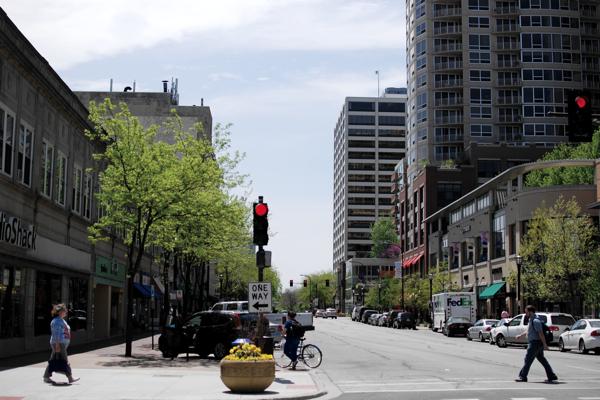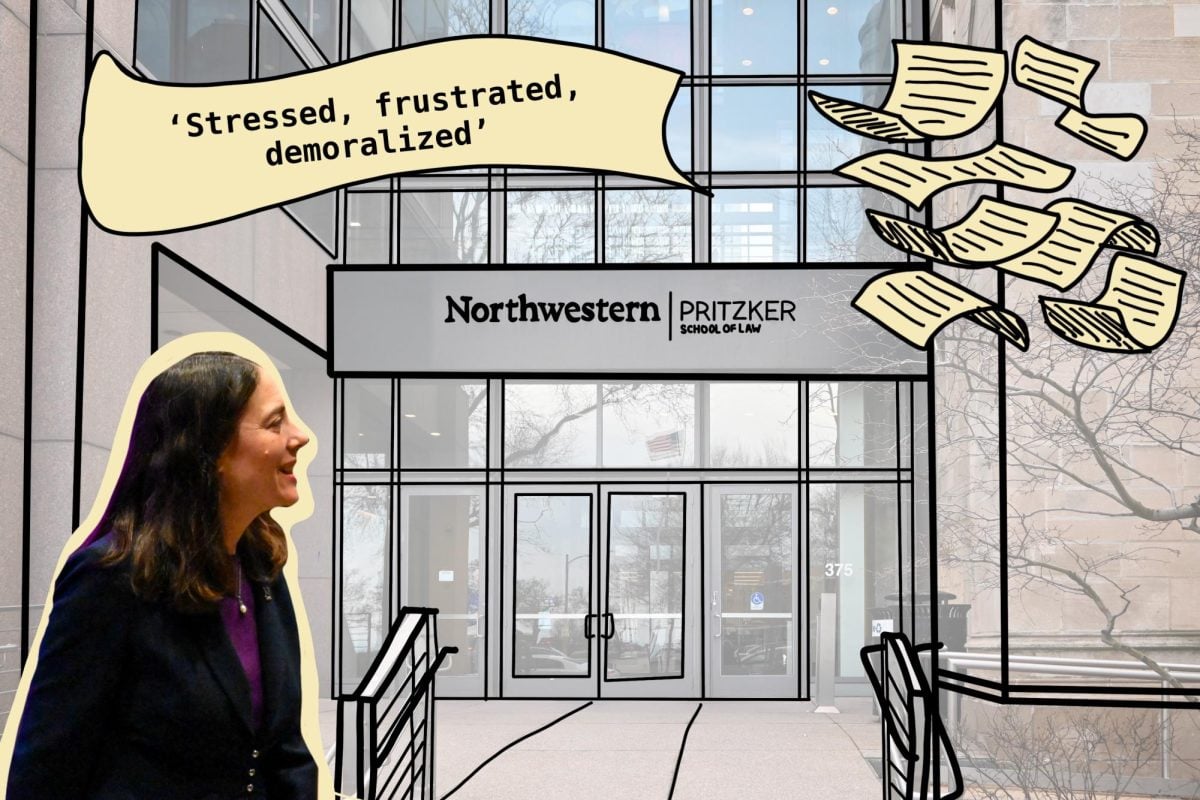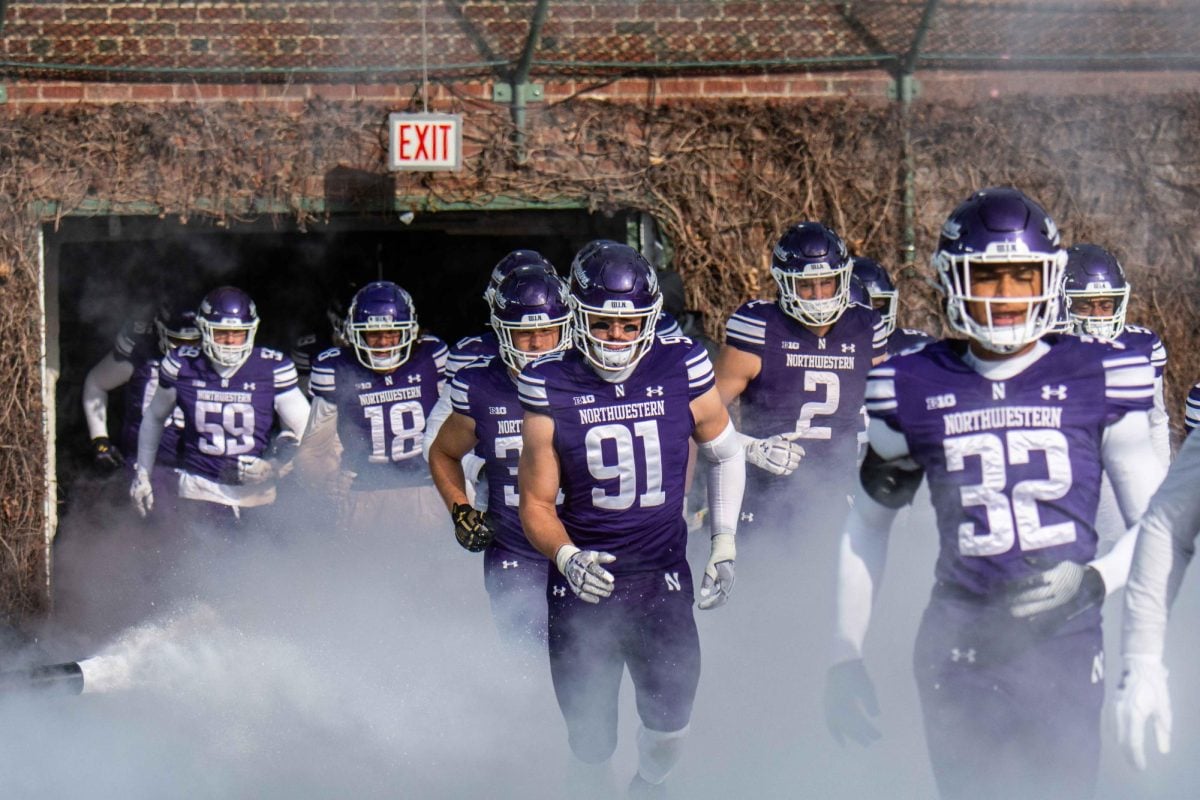
The ambient lighting and warmth of Found, a contemporary American bistro established in Evanston late last year, highlights its thoughtful, locally produced dishes. The restaurant sits at a refurbished storefront in town, taking the former space of Italian restaurant Gio at 1631 Chicago Ave.
With favorable reviews from publications like Chicago Magazine and The New York Times, Found defined itself as a culinary destination in a city heavy on dining options. But despite the bustle created by Found, three empty spaces sit idly nearby on Chicago Avenue.
Not every restaurant stays long in Evanston, and unlike Gio, some businesses are not easily replaced. Some spaces remain empty for more than a year before being filled, often by another restaurant that might not last for more than a few years — a cycle frequently repeated in the downtown area.
However, downtown Evanston’s success cannot be measured by popular restaurants or vacant storefronts alone. Economic development depends on careful attention to the entire city, and a thriving food scene is useless without additional retail and office space.
At Downtown Evanston’s annual meeting Thursday, the nonprofit organization that maintains and markets the downtown district announced nine new businesses are arriving in the coming months — seven of which are restaurants. The news came as the city works within new guidelines that prioritize attracting businesses of all types to Evanston and filling dozens of vacant storefronts.
“We’ve got all of the pieces in place to really have an excellent future, but we’ve got to keep focusing on that balance,” said Ald. Judy Fiske (1st), whose ward includes much of downtown Evanston.
But beyond rhetoric and strategic planning by city officials, obstacles specific to Evanston make breaking out of its food-focused market especially difficult.
“We need the balance in downtown,” Fiske said. “If we overbuild restaurants, that’s not good for us. If we overbuild residences, that’s not good for us.”
A holistic approach
In Evanston’s 2013 economic development work plan, the city outlines goals to maintain its economic assets, including industries involving water and the arts. The plan includes new targets, such as retaining retail attractions and workforce development. But unlike past plans, it also considers how the city’s economic goals work together.
With this new mindset, Evanston officials hope to tackle visible problems like empty storefronts while addressing more imperative issues, such as bringing more variety to downtown.
“The City Council has always focused on those components,” Fiske said. “What we’re doing now is looking at them in a holistic manner. That’s really important because you can’t take one part of it and not expect the other parts to be unaffected.”
Although the economic development plan includes standard targets for bringing business to downtown, Fiske says the city is taking these principles to all parts of the city for an all-encompassing strategy
A number of factors unique to Evanston could work in the city’s favor. Its lakefront location on the outskirts of Chicago and along Metra and Chicago Transit Authority lines — along with an eclectic food scene — give the suburb what officials call an excellent “quality of place.” The phrase refers to the benefits of aesthetic infrastructure, diverse communities and a vibrant city culture.
However, Evanston’s proximity to other shopping hubs counteracts some of those advantages. The city strives to bring in a mix of independent businesses and national chains, but downtown often competes with shopping centers like Westfield Old Orchard Mall in nearby Skokie and retail in Chicago. Many chains will not venture into Evanston if they already have a store only a few miles away, said Carolyn Dellutri, executive director of Downtown Evanston.
Fiske said downtown used to be home to several large department stores but lost many of them to Old Orchard. She noted the Evanston location for Marshall Field and Co. stuck around for many years before the defunct company was bought by Macy’s.
“Downtowns often have to reinvent themselves,” she said. “When the liquor laws changed in the ’70s, we were able to bring in more restaurants.”
A vision for downtown
Evanston is often cited as “the restaurant capital of Chicago’s North Shore.” Restaurants tend to do very well downtown, Dellutri said, particularly noting the recent success of Found.
Found owner Amy Morton said she has been blown away by positive press and the number of customers she receives on a daily basis. Although the number of repeat customers and Evanston residents makes Morton happy, she is also surprised by the number of people who come from outside the city.
Working with the city allowed the business to thrive, Morton said.
“It’s one of the best decisions I’ve ever made,” she said. “They simply have decided to be the sort of city that makes it easy for business owners. … They genuinely want people who come to Evanston to succeed.”
However, a heavy emphasis on dining interferes with the city’s goals of bringing national retail in and creating local shops downtown. From a city perspective, Fiske said she would like to see more tax revenue-generating businesses, but adding retail proves to be more complicated than simply attracting them to the area.
The size of downtown retail spaces makes it difficult for businesses to relocate, Fiske said. Even for retailers who create small boutique-sized shops designed for urban spaces, buildings in downtown tend to be too small for retail space. Some of the buildings formerly used by department stores in Evanston were demolished long ago, Fiske said.
Some retail still exists in downtown, including Williams Shoes on Church Street. The store has been in business for almost 60 years, and in that time it has expanded three times, owner Mike Lembeck said.
Lembeck said the expansion occurred naturally: He and his father, who passed the store onto him, never felt the space was too small. Rather, the store outlived nearby businesses and took their spaces, he said, allowing the business to utilize the available space downtown to the best of its ability. The most recent expansion, Williams Next Door, occupies a storefront across the hall from the original store.
Although he likes the restaurant scene, Lembeck said he wants more retail in downtown Evanston.
“At the moment, there’s not a lot of competition,” he said. “Over the years, there has been. We’ve just outlived everyone else.”
In lieu of national retailers, Fiske said she wants to dedicate some funds used by the economic development committee to help local retailers establish a name in downtown to “give them a leg up and see if that helps them.” Downtown also needs office spaces so workers can feed into the restaurants and retail.
“You’ve got a captive market, so they really do stay and spend a lot of money in the community they’re in,” she said. “We’re looking hard on how to market to offices and startups.”
Evanston has hosted several events to promote discussion on how to attract businesses to relocate their offices here, including a talk in early May by William Testa, vice president of the Federal Reserve Bank of Chicago.
“Evanston is a very special place,” Testa said during the event. “It’s a place where you can have the opportunity to be a job center … where people want to live at the same time.”
Because of Evanston’s unique location and quality of place, the city is looking to cater to businesses, said Paul Zalmezak, the city’s economic development committee coordinator.
“We have this sense that this is our niche to support those companies,” he said.
Creating downtown
In the late 1980s, the city conducted research to determine how to effectively develop downtown, Zalmezak said. Around this time, the city also created two tax-increment financing districts in downtown Evanston. TIF districts allow Evanston to use future tax revenue from those sections of the city to boost economic development over a 23-year period. After this time, funding for the areas is cut off.
The Downtown II TIF district, which expired in 2009, covered a large area west of Benson Avenue. The Washington National TIF district, effective until 2017, covers the area between Church and Davis streets, with Benson and Chicago avenues serving as its boundaries.
Using Evanston as a case study, four students from the Kellogg School of Management conducted research last year assessing the effectiveness of TIF districts.
The special tax districts can create lively areas of economic development, said second-year Kellogg student Seth Capron, who worked on the study. However, he said they can also be risky due to uncertainties in how local economies evolve. Some TIF districts receive money without clear goals, while others receive funds to boost an economy that is already beginning to recover, Capron said.
“A lot of risk involved for putting significant subsidies behind this is you don’t know what you’re achieving,” he said. “In some cases you might ask, ‘Would this have happened anyway?’”
The study found TIF districts work best when they align with a city’s goals because their outcomes may be uncertain on their own.
Compared to other similar districts across the country, both of Evanston’s downtown TIFs have been incredibly successful, Capron said. Downtown II created the Evanston Research Park, while Washington National allowed for significant building growth, he said.
Over time, the city has realized its economic strengths, like water industries, and weaknesses, like the need for greater workforce development, Zalmezak said.
“It’s different now,” he said. “We’ve identified important aspects of what makes Evanston unique in a very competitive marketplace.”
Bringing in business
When the TIF districts were formed in the heart of the city, Downtown Evanston was also putting down its roots. Since its establishment in 1987, the organization has become an integral part of economic development, linking the city, business owners and other stakeholders involved in creating businesses in Evanston.
“It really takes teamwork because when a business is looking to relocate, they may come in through different avenues,” Dellutri said.
The organization receives funds through a tax placed in what is known as Special Service Area No. 4, which covers the majority of downtown. In 2012, Downtown Evanston received almost $400,000 in revenue, which it uses to advertise downtown businesses and the area itself to potential businesses looking to set up shop.
The city approved an ordinance in 2007 to spread the boundaries of the tax area. The resulting increase in revenue allowed Downtown Evanston to become a full-time organization. Dellutri became its executive director the following year.
As the national economy recovers from the Great Recession, Dellutri said Evanston has been faring better, with 26 new businesses opening downtown in 2012.
“It’s helping establish a name for downtown Evanston,” she said.
Evanston has attracted popular Chicago restaurants to expand in the city. Establishments like Farmhouse, a midwestern tavern, and Lao Sze Chuan, a Chinese restaurant, are among the new businesses coming soon to the downtown district.
Partnerships with Northwestern also create prospects for economic opportunity. The Evanston Research Park, a joint project, includes a mix of University and city offices and helps promote business expansion.
Filling in the gaps
Despite the city’s notable efforts to bring in business, a noticeable number of empty storefronts remain. The current market is ultimately what influences which businesses want to find space in downtown Evanston, Dellutri said, but other factors are also at play.
Downtown Evanston’s site lists more than 100 office and retail spaces available for lease downtown. Some spaces have remained empty for more than two years, including the former Borders location on Orrington Avenue. However, Fiske said empty storefronts downtown do not reflect a poor economy. Rather, they can be attributed to conflicting interests between building owners and businesses, which prevent some spaces from being filled immediately, she said.
“A lot of these buildings are owned by local proprietors who have a specific vision for their buildings, and they’ll hold out until they get that,” Fiske said. “It’s not for a lack of people coming in.”
Vacancy rates were higher in 2008 during the economic downturn, but as the national economy recovers, many business owners are close to signing leases, Dellutri said.
One example of this is Naf Naf Grill, a Naperville-based Mediterranean chain. It will move into 1629 Orrington Ave., which has been vacant for more than two years. Business owners are also signing leases for the former spaces of STA Travel and Gamestop, two shops on Church Street that closed this year.
Dellutri announced several of these changes at the Downtown Evanston annual meeting last week. Other city officials announced projects that would also aid in economic development and in the creation of quality of place. Assistant city manager Marty Lyons presented plans to overhaul parking systems downtown, demonstrating a solar-powered, user-friendly pay box in lieu of a parking meter.
The city also approved plans to renovate Davis Street, including the creation of bike paths, sewer replacement, parking space realignment and street resurfacing.
“Although the project will create some disturbance, at the end of the day it will be a much better space like Church Street,” public works director Suzette Robinson said.
A plan with potential
Because it has been so highly developed, officials say downtown Evanston serves as a laboratory for economic development for the rest of the city. Within downtown, it is easier to see how each component works together and can be helpful when expanding the scope to include the rest of the city, Fiske said.
Capron said newer TIF districts near the intersections of Main and Chicago and Dodge and Dempster will address these blighted areas in a similar fashion to the downtown TIF districts.
Development initiatives on Howard Street and the construction of Trader Joe’s on Chicago Avenue will bring attention to areas outside downtown, Zalmezak said. In addition, Evanston is looking at how to fill vacant retail spaces beyond downtown and how to successfully bring in startups, he said.
Although Evanston’s holistic approach shows promise, it will take time before the plan becomes fully realized.
“We’ve finally hit our stride,” Fiske said. “(The work plan) understands that there’s a sense of place in Evanston that we have to market that’s unique from Chicago and other suburbs.”












